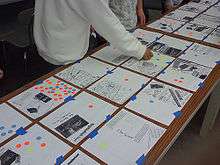Dotmocracy

Dotmocracy is an established facilitation method used to describe voting with dot stickers,[1] also known as “multi-voting”, “dot-voting”[2][3] or “voting with dots”.[4] In Dotmocracy participants vote on their favorite options using a limited number of stickers or marks with pens — dot stickers being the most common. This sticker voting approach is a form of cumulative voting.
Process specifics
The Dotmocracy process includes the following steps:
- Participants are each given a set number of dot stickers (as decided by the facilitator)
- They place dot stickers next to options presented that they like (they may place any number of their dots on any number of the options)
- Options with the most dots at the end of voting “win”
Variations include using different colour dots to signify different values, e.g. green for "like" and red for "dislike".
History
The origins of dot-voting are unclear. Professional facilitators have been said to use it since the 1980s .
Between 2004 and 2014, Jason Diceman published "Dotmocracy Sheets" and a "Dotmocracy Handbook" on his website Dotmocracy.org. Although the original Dotmocracy Sheets did use stickers, it quickly evolved to be very different to dot-voting.[5] In September 2014 Diceman renamed his website and materials as idea rating sheets[6]
Criticism
Dotmocracy has been criticized for limiting creativity and diversity of ideas, and giving confusing or false results. Dot-voting is like a one question multiple-choice survey done with stickers. Participants are expected to review, consider and compare all options before sticking their dots. As a result, too many options can be overwhelming and thus facilitators are encouraged to amalgamate and generalize unique ideas into broader and less specific concepts.
New options cannot be added once dotting has started, as this would not be fair to the new additions.
Similar or related options are penalized, as these can cause vote-splitting.
Participants can easily cheat by adding extra dots, peeling off dots or moving dots.
Often people will simply add their dots where everyone else has dotted, without considering their own opinion on all the options, thus an example of the Bandwagon effect.
See also
References
- ↑ Explanation of the Toronto Community Housing participatory budgeting process.
- ↑ Book “Collaboration Explained: Facilitation Skills for Software Project Leaders” page 129.
- ↑ “Group Brainstorming: Dot Voting with a Difference” article.
- ↑ A compiled thread from a discussion on the Electronic Discussion on Group Facilitation, 20 December 2000.
- ↑ http://dotmocracy.org/goodbye-hello-idea-rating-sheets
- ↑ http://www.idearatingsheets.org